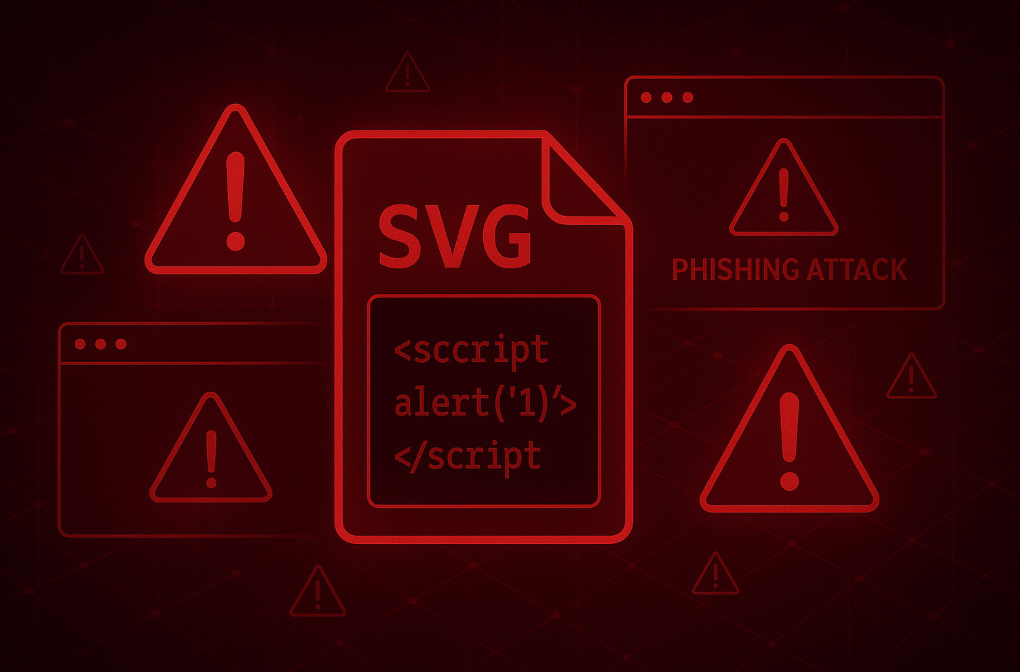Cybercriminals are increasingly weaponizing Scalable Vector Graphics (SVG) files—those XML-based, seemingly benign images—as advanced phishing tools and malware delivery mechanisms. These files are being leveraged to deliver JavaScript payloads, embed full fake login pages, and orchestrate multi-stage attacks, often bypassing traditional security filters focused on executable formats.
Why SVG Files Are Dangerous
SVG files differ from static image formats like JPEG or PNG in that they are XML-based. This enables embedding scripts, interactive elements, and styles—features that attackers exploit rather than legitimate images.
Moreover, W3C confirms that SVGs hosting scripts or CSS pose security risks when treated like conventional images Wikipedia.
Common SVG Attack Techniques
Cyber attackers exploit SVGs via multiple sophisticated tactics:
- Redirector SVGs: Craft SVGs embedding JavaScript that immediately redirects users to phishing sites upon rendering Wikipedia+12Cloudflare+12Seqrite+12.
- Self-contained Phishing Pages: SVG files include Base64-encoded HTML/CSS/JS that displays fake login forms, capturing credentials directly within the image Cloudflare+1.
-
Embedded Scripts (DOM Injection): Malicious
<script>tags or event handlers inside SVGs injected into trusted pages enable DOM manipulation—stealing cookies or injecting fake elements—in cases where Content Security Policy (CSP) is weak Cloudflare+2MITRE ATT&CK+2. - SVG Smuggling (MITRE T1027.017): Attackers covertly embed malware or payloads inside SVG files to bypass content filters and stage multi-step intrusions MITRE ATT&CK+1.
Notable Campaigns & Tools
Several real-world threat campaigns have leveraged SVGs:
-
AutoSmuggle-enabled Campaigns: Launched in December 2023 and January 2024, these campaigns used the tool AutoSmuggle to embed trojans such as XWorm RAT and Agent Tesla Keylogger inside SVGs.
The SVGs delivered embedded ZIP payloads, enabling phishing or malware execution Reddit+5Cofense+5Cloudflare+5. -
Cloudflare’s Threat Research (May 2025): Identified three primary SVG abuse patterns:
- Redirectors to credential harvesting sites, often using ephemeral cloud-hosted domains.
- Self-contained phishing within Base64-coded HTML.
- DOM manipulation via script injection in environments with weak sanitization or CSP Cloudflare+1.
- Mimecast Threat Findings (March 2025): Observed high-volume SVG phishing campaigns—over 2 million detections—using JavaScript redirects, layered redirects, CAPTCHAs, and fake attachments. These were used to harvest credentials and evade detection Saint Louis University+3Mimecast+3Cloudflare+3.
- IBM X‑Force Campaign (June 2025): Attackers targeted financial institutions using SWIFT-themed SVG lures. Payloads included RAT downloaders like STRRAT, deployed via Java-based malware and cloud-hosted infrastructure. The attackers also abused Telegram Bot APIs for C2 traffic, stealing Outlook data and files IBM.
- Seqrite Findings (August 2025): Observed SVG phishing via spear-phishing emails and cloud storage links. Attackers embedded script tags within CDATA blocks, using XOR and hex-encoded data to obfuscate code that executed payloads—redirecting targets stealthily Seqrite.
Attack Surface & Underlying Vulnerabilities
Attack vectors include:
- Cross-Site Scripting (XSS): SVGs embedded in web apps with poor sanitization allow script execution and user data theft Fortinet+2OPSWAT+2Cloudflare.
-
HTML Injection via
foreignObject: Permits embedding of arbitrary HTML content—enabling phishing and CSRF attacks Fortinet. - XML Entity Abuse (“Billion Laughs” attacks): Overloading entity expansion within SVGs leads to denial-of-service scenarios on flawed parsers Fortinet+2Reddit+2.
Recommendations for Cybersecurity Professionals
To defend against SVG-based threats, CISOs and cyber specialists should:
-
Reassess File Trust Assumptions
Treat SVGs as potentially executable—not merely images—and implement strict filtering or quarantining. -
Harden Email and Proxy Defenses
Deploy advanced detection that inspects SVG payloads for obfuscation, scripting, and embedded redirects (as Mimecast and Cloudflare have done) Seqrite+1Cloudflare. -
Implement Endpoint and Network Protections
Monitor for SVG execution followed by secondary downloads or script execution (MITRE T1027.017 detection logic) MITRE ATT&CK+1. -
Use Browser Sandboxing and Isolation
Execute SVGs in sandboxed environments to mitigate browser-based exploits MITRE ATT&CK. -
Enforce CSP and Content Sanitization
Restrict inline scripting and isolate SVGs from critical web contexts to mitigate DOM injection. -
Conduct User Awareness Training
Educate staff on unusual attachments, especially SVGs disguised as voice messages or invoices, and encourage reporting of suspicious content IBM+11Sophos News+11cyber.nj.gov+11MITRE ATT&CK+3Mimecast+3Cloudflare+3IBM. -
Adopt Detection and Threat Hunting Playbooks
Use threat telemetry and hunting rules for SVG anomalies, hashed indicators, or campaign fingerprints (e.g., Mimecast IOCs, IBM STRRAT artifacts) Cloudflare+2MITRE ATT&CK+2.
Conclusion
SVG files have transformed from innocent vector images into potent threat actors in modern phishing and malware campaigns. Their XML nature, scriptability, and poor handling by conventional defenses make them an attractive tool for adversaries. For CISOs and cyber professionals, recognizing SVGs as executable attack vectors—and implementing vigilant controls—is now a critical imperative.

